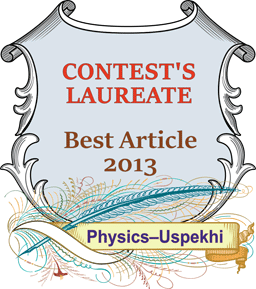 |
RSS feeds |
|
|||||
| Issue 12, 2025 |
|
||||||
|
|
|
||||||
Issues/2013/January |
← → |
| Physics of our days |
Active colloids
a Materials Science Division, Argonne National Laboratory, 9700 South Cass Ave., Argonne, Illinois, 60439, USA
b Department of Engineering Sciences and Applied Mathematics, Northwestern University, 2145 Sheridan Rd, Evanston, Illinois, 60208, USA

A colloidal suspension is a heterogeneous fluid containing solid microscopic particles. Colloids play an important role in our everyday life, from food and pharmaceutical industries to medicine and nanotechnology. It is useful to distinguish two major classes of colloidal suspensions: equilibrium and active, i.e., maintained out of thermodynamic equilibrium by external electric or magnetic fields, light, chemical reactions, or hydrodynamic shear flow. While the properties of equilibrium colloidal suspensions are fairly well understood, active colloids pose a formidable challenge, and the research is in its early exploratory stage. One of the most remarkable properties of active colloids is the possibility of dynamic self-assembly, a natural tendency of simple building blocks to organize into complex functional architectures. Examples range from tunable, self-healing colloidal crystals and membranes to self-assembled microswimmers and robots. Active colloidal suspensions may exhibit material properties not present in their equilibrium counterparts, e.g., reduced viscosity and enhanced self-diffusivity, etc. This study surveys the most recent developments in the physics of active colloids, both in synthetic and living systems, with the aim of elucidation of the fundamental physical mechanisms governing self-assembly and collective behavior.
|
PACS: 47.15.G−, 47.57.J−, 47.63.Gd, 64.75.Yz, 81.05.Xj ()
DOI: URL: https://ufn.ru/en/articles/2013/1/e/  https://youtu.be/AH73LjynJ7U https://youtu.be/AH73LjynJ7U  https://rutube.ru/video/988c4d07d9430dcf25b23974042d1529/ https://rutube.ru/video/988c4d07d9430dcf25b23974042d1529/  000317578800004 000317578800004  2-s2.0-84876562850 2-s2.0-84876562850  2013PhyU...56...79A 2013PhyU...56...79A Citation: Aranson I S "Active colloids" Phys. Usp. 56 79–92 (2013) Received: 17th, July 2012, revised: 2nd, October 2012, accepted: 18th, September 2012 Оригинал: Арансон И С «Активные коллоиды» УФН 183 87–102 (2013); |
|
© 1918–2025 Uspekhi Fizicheskikh Nauk Email: ufn@ufn.ru Editorial office contacts About the journal Terms and conditions |